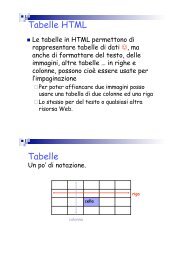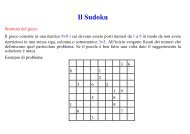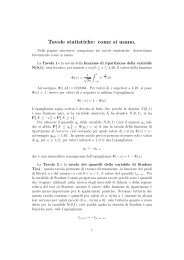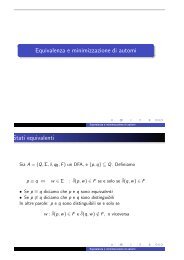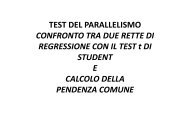Test per il confronto di 2 proporzioni , Analisi di dati qualitativi ...
Test per il confronto di 2 proporzioni , Analisi di dati qualitativi ...
Test per il confronto di 2 proporzioni , Analisi di dati qualitativi ...
You also want an ePaper? Increase the reach of your titles
YUMPU automatically turns print PDFs into web optimized ePapers that Google loves.
<strong>Analisi</strong> <strong>di</strong> <strong>dati</strong> <strong>qualitativi</strong>Per effettuare <strong>il</strong> <strong>confronto</strong> fra le frequenze osservate e le frequenze attese, in baseall’ipotesi nulla H 0 , si ut<strong>il</strong>izza <strong>il</strong> test statistico del chi-quadratoχ 2 = Σ(O-A) 2ALa sommatoria include tutte le coppie <strong>di</strong> frequenze osservate-atteseEsempioIn una data popolazione le probab<strong>il</strong>ità <strong>di</strong> nascita <strong>per</strong> i due sessi sonoP(M) = π = 0.506 P(F) = (1- π ) =0.494E(x) = n π ; Var(x)= n π(1- π )Si consideri una serie <strong>di</strong> campioni <strong>di</strong> 100 nascite ciascunoFrequenze Attese <strong>per</strong> ogni campione <strong>di</strong> 100 nascite M= 50.6 F= 49.4Frequenze OsservateM F Σ (O-A) 2 /A χ 251 49 (51-50.6) 2 /50.6 + (49-49.4) 2 /49.4 0.00650 50 (50-50.6) 2 /50.6 + (50-49.4) 2 /49.4 0.01452 48 (52-50.6) 2 /50.6 + (48-49.4) 2 /49.4 0.07849 51 (49-50.6) 2 /50.6 + (51-49.4) 2 /49.4 0.10253 47 (53-50.6) 2 /50.6 + (47-49.4) 2 /49.4 0.23048 52 (48-50.6) 2 /50.6 + (52-49.4) 2 /49.4 0.27054 46 (54-50.6) 2 /50.6 + (46-49.4) 2 /49.4 0.46247 53 (47-50.6) 2 /50.6 + (53-49.4) 2 /49.4 0.51844 56 (44-50.6) 2 /50.6 + (56-49.4) 2 /49.4 1.74360 40 (60-50.6) 2 /50.6 + (40-49.4) 2 /49.4 3.535Supponendo che la serie includa ad es. 250 campioni <strong>di</strong> n=100, la <strong>di</strong>stribuzione <strong>di</strong>frequenza dei χ 2 calcolati nei 250 campioni puo’ essere:χ 2 0.0- 0.5- 1.0- 1.5- 2.0- 2.5- 3.0- 3.5- 4.0- 4.5- 5.+ totFreq 121 41 21 24 14 7 6 7 3 2 4 250Se si passa al continuo, <strong>per</strong> un numero infinito <strong>di</strong> campioni si arriva alla funzione f(χ 2 ) =funzione <strong>di</strong> densità <strong>di</strong> probab<strong>il</strong>ità della v.c. χ 2 1F 3





